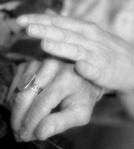AARP Hearing Center
By Dick Weinman, The Thin Edge of Dignity

I write this blog key by key, my green, hard-rubber, T-shaped, tool held in my right fist, striking one character after the other – my finger prosthetic at work. Here’s why:
On Tuesday, July 21, 2005, at about 8:30 in the morning, I was on the way to prepare breakfast and feed my Alzheimer’s stricken wife at her dementia facility.
I never got there.
My Honda Odyssey mini-van and a cement mixer truck collided head-on. The truck was victorious.
That was the end of the ordinary in life as I had known it for seventy-two years. In fact, it was the end of my life – at least, temporarily - but for resuscitation technology and the skill of doctors. The technology re-started my heart and kept me breathing; the doctors’ skills put my broken, fractured, burned body back together. . . more or less.
And so began what was to be my life-long passage through an Assisted Living Facility, or ALF, a unique phenomenon of Western Culture, mysterious in the dynamics of human interaction. It was to be a journey in which the common and ordinary activities of living became uncommon and extraordinary, requiring thought instead of habit, by those who assisted me – and I needed assistance. Big time.
Take two specific and usually ordinary and seemingly insignificant actions:
A cup of water is poured for me and set on a counter. Ordinarily I would reach out for the cup, grasp it by one of its handles, and drink. Now, that I’m seated in a wheel chair, below the counter (ironically, non – ADA designed) if the cup is not placed close to the edge, I can’t reach it. And, since the fingers of my left hand are stiffly immobile and curved into a partial fist, if the cup handle is not accessible to, or handed to, my right hand, I’m unable to grasp the cup. No drink.
Another incidental and habitual action: my glasses need to be wiped.
Commonly, the person who wipes them for me, when done, closes the temples of the frame over the lenses, and lays the glasses on a table or desk top. Ordinarily, I would spread the temples apart with both hands, grasp each temple, and slip on the frames. But with my hands in an unordinary condition, I can only spread apart the temples by grasping the left temple with my teeth, while balancing the frame on my thigh, raising the right temple with my right hand, which I can somewhat use, and slipping the frame – unbalanced and askew – over my eyes. Better for the person who cleans my glasses not to close the temples over the lenses, as ordinarily done.
The Thin Edge of Dignity will be a series of monthly blogs depicting my daily living transactions as a resident of an Assisted Living Facility (ALF).
The blogs describe how the most basic of functions, from waking to sleeping – the passage of a single day – have become, because of my inabilities, uncommon and extraordinary: newly conceived rituals of daily living. As I pass through these rituals, I wonder if my caregiver knows what thoughts meander through my head; the emotional roller coaster that rises and falls in my spirit and mind. Does she know how a once independent person feels when he has to be put to bed? To be dressed? To be put into pajamas? To have his teeth brushed? Wiped after using the toilet?
To be on the thin edge of dignity, close to tumbling over?
As I write these blogs and mentally re-enact the activities they picture, I smile at how absurd they can be; yet I need them because of my inabilities . . . disabilities. They are pregnant with humor; the comedy of the incongruous. For me, at one time free and independent; now, controlled - an independent spirit in a dependent frame. Sad, but ludicrous. And what is laughter, but a release of tension, a barricade to depression?
At the same time, I ask myself: what is my future and the future of the residents of this community? Sure, I’m disabled. But a handful of residents are independent; they’re here for the convenience of being served three meals a day – no grocery shopping or cooking; of having their laundry done for them, and other inconveniences of a solitary life.
But most of us are here because we can’t perform life’s daily transactions. A few others are disabled, like me, but from strokes and diseases like Parkinson’s. They, too, can’t toilet, shower, or handle their own hygiene. Some show signs of dementia or Alzheimer’s at varying stages of memory loss. For these reasons, most residents need their medications given to them when and as prescribed. Diabetics need insulin shots. And face it: it’s inherent in our culture: all residents are just old – some septuagenarians; most in their eighties and nineties. This mosaic of conditions, chronic illnesses, disabilities, means that all need assistance of one kind or other. Hence an ALF.
Where do I and the rest of the community go from here? Well, this isn’t a half way house. It’s a stop on a journey. The chronically ill don’t get better. Memory isn’t restored. Disabilities don’t disappear. It’s not like Robert Frost’s celebrated poem, The Road Not Taken:
“two roads diverged in a yellow wood, and sorry I could not travel both. . .”
That’s how apartments become available. How those on the outside become residents. How I got in. The cycling and recycling of life. That’s why one has to laugh.































































